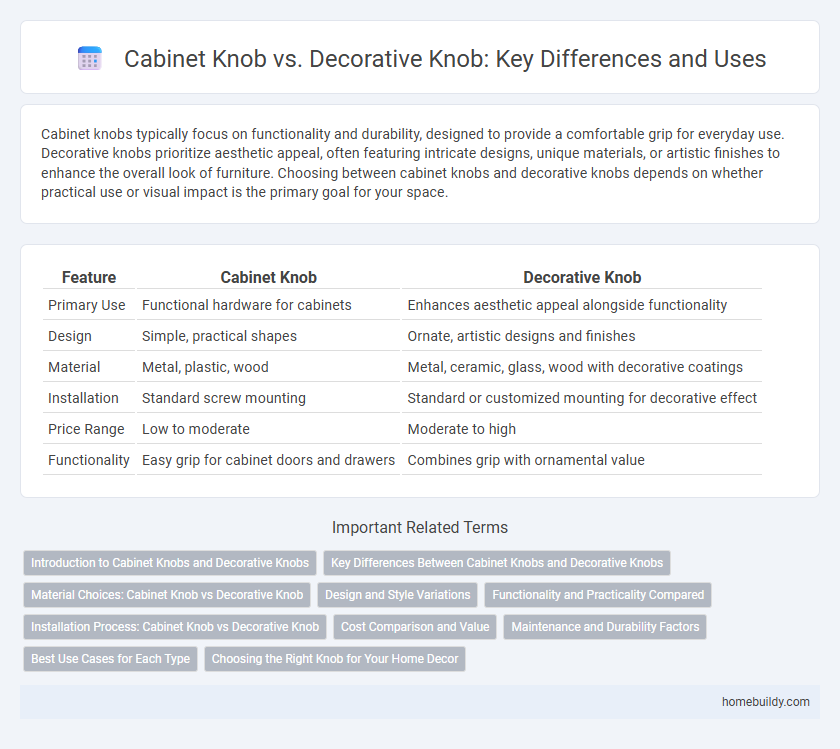Cabinet knobs typically focus on functionality and durability, designed to provide a comfortable grip for everyday use. Decorative knobs prioritize aesthetic appeal, often featuring intricate designs, unique materials, or artistic finishes to enhance the overall look of furniture. Choosing between cabinet knobs and decorative knobs depends on whether practical use or visual impact is the primary goal for your space.
Table of Comparison
| Feature | Cabinet Knob | Decorative Knob |
|---|---|---|
| Primary Use | Functional hardware for cabinets | Enhances aesthetic appeal alongside functionality |
| Design | Simple, practical shapes | Ornate, artistic designs and finishes |
| Material | Metal, plastic, wood | Metal, ceramic, glass, wood with decorative coatings |
| Installation | Standard screw mounting | Standard or customized mounting for decorative effect |
| Price Range | Low to moderate | Moderate to high |
| Functionality | Easy grip for cabinet doors and drawers | Combines grip with ornamental value |
Introduction to Cabinet Knobs and Decorative Knobs
Cabinet knobs serve as functional hardware designed for easy opening and closing of cabinets, emphasizing ergonomics and durability. Decorative knobs prioritize aesthetic appeal with intricate designs, textures, and materials that enhance interior decor while maintaining basic functionality. Both types vary in size, shape, and finish, allowing customization to match specific styles from modern to vintage.
Key Differences Between Cabinet Knobs and Decorative Knobs
Cabinet knobs primarily serve functional purposes, offering a secure grip for opening and closing drawers and doors, while decorative knobs emphasize aesthetic enhancement with intricate designs and unique finishes. Material composition often varies; cabinet knobs frequently use durable metals like stainless steel or brass for longevity, whereas decorative knobs might incorporate ceramics, glass, or resin to achieve various visual styles. Size and shape differences also exist, as cabinet knobs are typically compact and ergonomic, whereas decorative knobs can be larger or uniquely shaped to complement interior decor themes.
Material Choices: Cabinet Knob vs Decorative Knob
Cabinet knobs typically prioritize durable materials like stainless steel, brass, and zinc alloy to withstand heavy use in kitchens and bathrooms. Decorative knobs often feature more varied materials such as glass, ceramic, and wood, emphasizing aesthetic appeal over durability. Material choices impact the functionality and style, with cabinet knobs favoring strength and decorative knobs offering more customized design options.
Design and Style Variations
Cabinet knobs offer a wide range of design and style variations tailored for functionality and subtle elegance, typically featuring simple shapes and finishes suitable for everyday use. Decorative knobs prioritize aesthetic appeal with intricate patterns, unique materials, and artistic details, transforming furniture into statement pieces. Both types provide customization options, but decorative knobs emphasize visual impact while cabinet knobs focus on practicality and ease of use.
Functionality and Practicality Compared
Cabinet knobs are designed primarily for functionality, providing a secure grip to easily open and close cabinet doors and drawers. Decorative knobs often emphasize aesthetic appeal, sometimes at the expense of ergonomic comfort and durability. Selecting a cabinet knob balances practical use with design, ensuring ease of operation while complementing interior decor.
Installation Process: Cabinet Knob vs Decorative Knob
Cabinet knobs typically feature a straightforward installation process involving a single screw, making them easy to attach and replace on most cabinet doors and drawers. Decorative knobs often require additional steps due to their intricate designs and multiple attachment points, which can demand more precise alignment and extra hardware for secure mounting. Choosing between cabinet knobs and decorative knobs impacts installation time and effort, with cabinet knobs favoring simplicity and decorative knobs emphasizing aesthetic complexity.
Cost Comparison and Value
Cabinet knobs generally offer a more affordable option compared to decorative knobs, with prices varying between $2 to $10 per piece, while decorative knobs often range from $15 to $50 or more due to intricate designs and premium materials. The value of cabinet knobs lies in their simplicity and functionality, making them ideal for budget-conscious renovations without sacrificing usability. Decorative knobs provide aesthetic enhancement and can increase property appeal, potentially justifying the higher cost for upscale or custom cabinetry projects.
Maintenance and Durability Factors
Cabinet knobs typically feature simpler designs with durable materials such as metal or solid wood, making maintenance straightforward and long-lasting under frequent use. Decorative knobs often incorporate intricate details and varied materials, which may require more careful cleaning to prevent damage and may wear faster due to delicate finishes. Prioritizing cabinet knobs with corrosion-resistant finishes and sturdy construction enhances durability and minimizes upkeep compared to ornate decorative options.
Best Use Cases for Each Type
Cabinet knobs are ideal for functional spaces like kitchens and bathrooms where durability and ease of grip are essential, offering a straightforward design that complements various cabinetry styles. Decorative knobs excel in areas such as bedrooms or living rooms, where style and aesthetic appeal take precedence, adding unique character or themed accents to furniture. Selecting between cabinet and decorative knobs depends on whether practicality or ornamental value is the primary requirement for the space.
Choosing the Right Knob for Your Home Decor
Choosing the right cabinet knob involves balancing functionality with aesthetic appeal, where cabinet knobs prioritize practicality and ease of use, while decorative knobs emphasize style and intricate design. Cabinet knobs made from durable materials like stainless steel or brushed nickel provide long-lasting performance, whereas decorative knobs often feature unique finishes and detailing that enhance the visual appeal of furniture. Selecting between a cabinet knob and a decorative knob depends on the desired impact on home decor and the level of daily usage expected, ensuring a harmonious blend of form and function.
cabinet knob vs decorative knob Infographic

 homebuildy.com
homebuildy.com